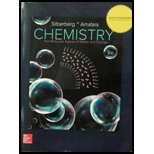
Concept explainers
(a)
Interpretation:
The given reaction equation has to be balanced.
Concept introduction:
Balanced equation: A balanced chemical equation is an equation which contains same elements in same number on both the sides (reactant and product side) of the chemical equation thereby obeying the law of conservation of mass.
The equation for a reaction, which has same number of atoms and charge of the ions in both reactants and product sides, is known as balanced equation.
(a)
Answer to Problem 20.107P
Balanced equation is,
Explanation of Solution
The given statement of equation can be completed by writing as follows,
Balancing the equation:
The given process of respiration, glucose is oxidized completely to give
In fermentation process, oxygen
In third reaction, ethanol is oxidized to
A balanced equation will have same elements, and same number of atoms of each side of the reaction.
(b)
Interpretation:
For respiration reaction
Concept introduction:
Free energy (Gibbs free energy) is the term that is used to explain the total energy content in a
(b)
Answer to Problem 20.107P
The
Explanation of Solution
The resiparation of glucose reaction is,
Calculate the Free enrgy change
Standared Free energy change equation is,
Calculate the free energy change for this reaction as follows,
Hence, the standard free energy is
Next solving for resipration
Therefore, the
(c)
Interpretation:
For fermentation reaction of
Concept introduction:
Free energy (Gibbs free energy) is the term that is used to explain the total energy content in a thermodynamic system that can be converted into work. The free energy is represented by the letter
(c)
Answer to Problem 20.107P
The
Explanation of Solution
The resiparation of glucose reaction is,
Calculate the Free enrgy change
Standared Free energy change equation is,
Calculate the free energy change for this reaction as follows,
The fermentation reaction standard free energy is
Next solving for fermentation
Therefore, the
(d)
Interpretation:
For oxidation reaction of
Concept introduction:
Free energy (Gibbs free energy) is the term that is used to explain the total energy content in a thermodynamic system that can be converted into work. The free energy is represented by the letter
(d)
Answer to Problem 20.107P
The 1.00 g of ethanol oxidation process standard free energy is
Explanation of Solution
The resiparation of glucose reaction is,
Calculate the Free enrgy change
Standared Free energy change equation is,
Calculate the free energy change for this reaction as follows,
Ethanol oxidation reaction standard free energy is
Next solving for fermentation
Therefore, the 1.00 g of ethanol oxidation process standard free energy is
Want to see more full solutions like this?
Chapter 20 Solutions
CHEMISTRY >CUSTOM<
- Synthesize 2-Ethyl-3-methyloxirane from dimethyl(propyl)sulfonium iodide using the necessary organic or inorganic reagents. Draw the structures of the compounds.arrow_forwardSynthesize 2-Hydroxy-2-phenylacetonitrile from phenylmethanol using the necessary organic or inorganic reagents. Draw the structures of the compounds.arrow_forwardSynthesize N-Methylcyclohexylamine from cyclohexanol using the necessary organic or inorganic reagents. Draw the structures of the compounds.arrow_forward
- Synthesize N-Methylcyclohexylamine from cyclohexanol using the necessary organic or inorganic reagents. Draw the structures of the compounds.arrow_forwardIf possible, please provide the formula of the compound 3,3-dimethylbut-2-enal.arrow_forwardSynthesize 1,4-dibromobenzene from acetanilide (N-phenylacetamide) using the necessary organic or inorganic reagents. Draw the structures of the compounds.arrow_forward
- Indicate the products obtained by mixing (3-oxo-3-phenylpropyl)triphenylphosphonium bromide with sodium hydride.arrow_forwardWe mix N-ethyl-2-hexanamine with excess methyl iodide and followed by heating with aqueous Ag2O. Indicate the major products obtained.arrow_forwardIndicate the products obtained by mixing acetophenone with iodine and NaOH.arrow_forward
- Indicate the products obtained by mixing 2-Propanone and ethyllithium and performing a subsequent acid hydrolysis.arrow_forwardIndicate the products obtained if (E)-2-butenal and 3-oxo-butanenitrile are mixed with sodium ethoxide in ethanol.arrow_forwardQuestion 3 (4 points), Draw a full arrow-pushing mechanism for the following reaction Please draw all structures clearly. Note that this intramolecular cyclization is analogous to the mechanism for halohydrin formation. COH Br + HBr Brarrow_forward
 ChemistryChemistryISBN:9781305957404Author:Steven S. Zumdahl, Susan A. Zumdahl, Donald J. DeCostePublisher:Cengage Learning
ChemistryChemistryISBN:9781305957404Author:Steven S. Zumdahl, Susan A. Zumdahl, Donald J. DeCostePublisher:Cengage Learning ChemistryChemistryISBN:9781259911156Author:Raymond Chang Dr., Jason Overby ProfessorPublisher:McGraw-Hill Education
ChemistryChemistryISBN:9781259911156Author:Raymond Chang Dr., Jason Overby ProfessorPublisher:McGraw-Hill Education Principles of Instrumental AnalysisChemistryISBN:9781305577213Author:Douglas A. Skoog, F. James Holler, Stanley R. CrouchPublisher:Cengage Learning
Principles of Instrumental AnalysisChemistryISBN:9781305577213Author:Douglas A. Skoog, F. James Holler, Stanley R. CrouchPublisher:Cengage Learning Organic ChemistryChemistryISBN:9780078021558Author:Janice Gorzynski Smith Dr.Publisher:McGraw-Hill Education
Organic ChemistryChemistryISBN:9780078021558Author:Janice Gorzynski Smith Dr.Publisher:McGraw-Hill Education Chemistry: Principles and ReactionsChemistryISBN:9781305079373Author:William L. Masterton, Cecile N. HurleyPublisher:Cengage Learning
Chemistry: Principles and ReactionsChemistryISBN:9781305079373Author:William L. Masterton, Cecile N. HurleyPublisher:Cengage Learning Elementary Principles of Chemical Processes, Bind...ChemistryISBN:9781118431221Author:Richard M. Felder, Ronald W. Rousseau, Lisa G. BullardPublisher:WILEY
Elementary Principles of Chemical Processes, Bind...ChemistryISBN:9781118431221Author:Richard M. Felder, Ronald W. Rousseau, Lisa G. BullardPublisher:WILEY





